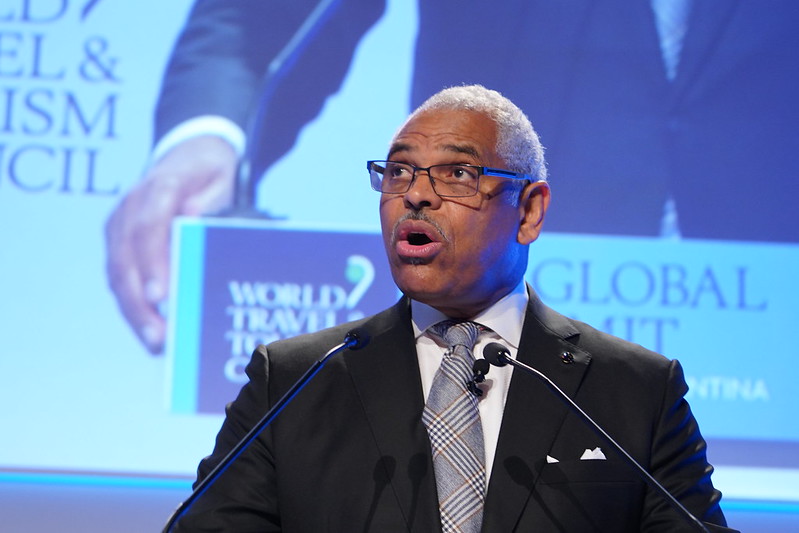“This should have been a year for shared sacrifice,” said one economist. “Instead it became a year of shielding CEOs from risk while it was the frontline employees who paid the price.”
By Kenny Stancil, staff writer for Common Dreams. Published 5-28-2021

Carnival CEO Arnold Donald’s pay package in 2020 surged to $13.3 million, a 19% increase over the previous year, even though the cruise operator recorded losses of $10.2 billion. Photo: World Travel & Tourism Council/flickr/CC
Even as the Covid-19 pandemic created record losses in the second quarter of 2020—and claimed the lives and livelihoods of millions of workers—median CEO pay in the U.S. increased yet again last year, according to a new analysis.
At a time when “CEOs’ big pay packages seemed to be under as much threat as everything else,” many boards of directors “made changes to the intricate formulas that determine” executive compensation to “make up for losses created by the crisis,” the Associated Press reported Friday.
“This should have been a year for shared sacrifice,” Sarah Anderson, director of the Global Economy Project at the Institute for Policy Studies (IPS), told AP. “Instead it became a year of shielding CEOs from risk while it was the frontline employees who paid the price.”
Despite the coronavirus-driven economic downturn, which reduced corporate profits and in theory should have lowered executive compensation, “the median pay package for a CEO at an S&P 500 company hit $12.7 million in 2020,” AP noted.
That’s “5% more than the median pay for that same group of CEOs in 2019,” the news outlet added.
To take one example, the cruise operator Carnival took a $10.2 billion hit last year, a reflection of the pandemic’s impact on the travel industry. Nevertheless, CEO Arnold Donald’s pay package in 2020 surged to $13.3 million—a 19% increase over the previous year and 490 times more than the company’s median worker pay, which is just $27,151.
As AP explained, Carnival cut Donald’s salary, but it also showered him with grants of restricted stock. The stock grants that Donald received were valued at $5.2 million, which helps explain how his pay rose while his company sank.
Before she testified at the March hearing on the nation’s income and wealth inequality crisis that was convened by Senate Budget Committee Chairman Bernie Sanders (I-Vt.), Anderson told Common Dreams that the rise of stock-based compensation for CEOs was one of the key drivers, along with a decades-long assault on labor unions, of the widening gulf between what corporate executives and typical workers are paid.
Last year, in contrast to the average raise of 5% enjoyed by CEOs, wages and benefits for all non-government workers increased by 2.6%, AP reported. Part of that growth, however, is attributable to the fact that mass unemployment hit poorly paid workers particularly hard. Millions of U.S. workers lost their jobs as the economy shut down, and more low-wage employees were affected than the relatively well-remunerated professionals who could work from home.
Most CEOs, meanwhile, did exceptionally well amid the widespread suffering.
“Overall, 61% of the 342 CEOs in this year’s survey did get a boost in compensation last year,” AP reported. “That’s almost the exact same percentage as the 62% in 2019, when the economy and corporate profits were growing.”
Another recent report co-authored by Anderson and IPS associate fellow Sam Pizzigati painted an even starker picture of the diverging fortunes of CEOs and workers. According to the IPS report, 51 of the nation’s 100 largest low-wage employers manipulated their own rules to boost executive compensation amid the pandemic.
As a result, CEO pay at those companies averaged $15.3 million in 2020, up 29% from 2019. By contrast, the report found that median worker pay at the same companies declined by 2% to an average of $28,187. The CEO-to-median-worker pay ratio at those 51 corporations averaged 830-to-1 last year.
According to the latest research on the topic conducted by the Economic Policy Institute (EPI), top CEOs in the U.S. were paid 320 times as much as typical workers in 2019. Between 1978 and 2019, EPI found, CEO pay soared by 1,167% while typical worker pay grew by just 13.7%. For historical perspective, the ratio of CEO-to-median-worker compensation was 21-to-1 in 1965 and 61-to-1 in 1989.
In March, Sanders introduced the Tax Excessive CEO Pay Act, which would increase the corporate tax rate by 0.5% for companies that pay their CEOs over 50 times more than the median worker, and 5% for companies that pay their chief executives over 500 times more than the median worker.
“Over the past year, low-wage workers have demonstrated—perhaps more clearly than ever before—just how essential they are to our economy and our health,” Anderson wrote earlier this week. “It’s time for public policy to shift corporate America away from a business model that creates prosperity for a few at the top and precarity for so many of the rest of us.”

